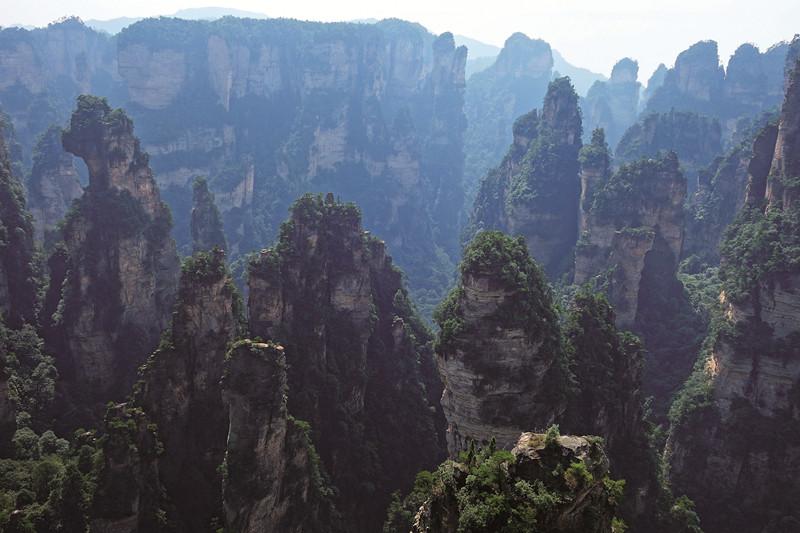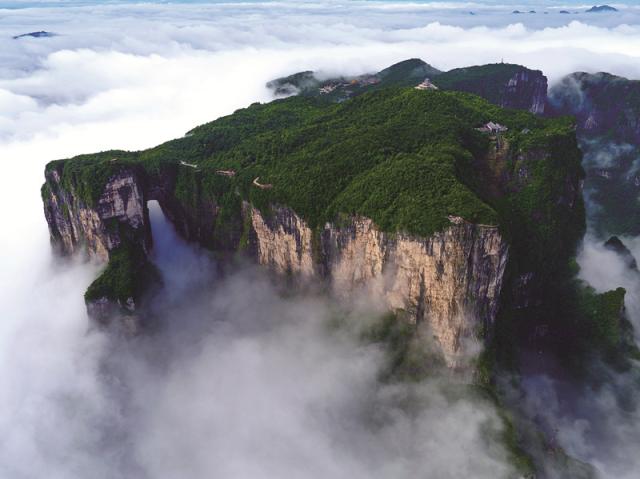
 Old Version
Old Version
Zhangjiajie: Fantasy rock formations

Anyone who has seen the 3D fantasy Avatar will feel strangely at home when entering the alien landscape of Zhangjiajie (“Zhang Family Homeland”). The sandstone rock formations, including around 3,000 pillars, tower into the clouds and look spectacular in all seasons, as screens and posters around the national park insist.
After getting off a minibus from Zhangjiajie City bus station, we would soon discover how the reserve is remarkable not just for the scenery, but, well, for its infrastructure. Anyone who’s visited big tourist sites in China may have felt more overwhelmed by the crowds and chaos, the loudspeakers and sense of panic than the majesty of anything Ming dynasty. Zhangjiajie, in contrast, has made some bold moves to tackle people flow that make it surprisingly pleasant.
The canyons and cliffs, forests and lakes cover an area of 700 square kilometers, with a ruthlessly enforced perimeter more akin to that used to keep dinosaurs contained in Spielberg’s earlier hit, Jurassic Park, a theme that continues with transport. Private vehicles are basically banned, replaced instead by a fleet of free electric busses that serve a vast network of stops in the main area. Around the fringes a fleet of minibuses connect outlying spots and can be hailed anywhere. They’re clean, quick and there’s plenty of staff to manage the crowds to make sure boarding is relatively humane and that you’re getting on the right bus (most of the time).
There are a few circuits to explore: Huangshi, Golden Whip (Jinbianxi), Wulong, Chapanta and Tianzishan. Despite being a World Heritage Site, bang in the middle of the park is the Bailong Elevator, nailed to the side of a cliff and listed as the highest outdoor lift in the world. This ends up serving as a useful, if both financially and environmentally costly, means of getting between areas of the park on different levels, as the glass elevator whips you another 326 meters up to a plateau. Just make sure you don’t need to go back down around 5-7pm when the majority of visitors are leaving the park via the elevator.
The different areas offer views not just of different collections of the crumbling towers, some over 200 meters high, but from different angles. Climb or take the cable car up to the Huangshi circuit and you’re level with the stacks at a distance. Follow the Golden Whip trail along the river and they tower above you. Make your way around the Wulong and Tianzishan areas and you’re at the edge of cliffs with pillars of different heights close by. Wulong even lets you climb a series of metal ladders up on to the top of the Tianbo Mansion pillar and offers the opportunity of crossing the Greatest Bridge Under Heaven, where two huge stacks meet to form a bridge which is all the more impressive when viewed from afar.
Along with the rocky wonders are other natural delights. The climate lends itself to a staggering number of tree species - over 500. There are giant salamander in the rivers, though we didn’t see any. What’s harder to miss are the monkeys. Be warned – they are dangerous wild animals that can and will creep up on you and start opening your backpack from behind.
Those looking to venture off on hikes may be somewhat disappointed. First of all, the maps are all terrible and wildly different. Any maps on your phone are equally helpless. We managed to get lost coming down the side of a mountain, partly because a villager had built her house across where the path went, though she did lead us through her guesthouse and down off her back patio where we found another path through scenery the closest we’ll ever get to being on a fantasy planet. Then at the bottom we had to take off our shoes and wade across a river to rejoin the general flow of the path network.
What the park lacks in hiking trails, it more than makes up for with its stupendous cable car rides that dangle visitors through the quartzite stacks, past trees clinging on for survival, brushing along cliffs and up through clouds. Those wanting more leisure transport options can take a monorail or launches on certain parts of the lakes.
The natural beauty and random improbability of the scenery, matched with the unexpected and equally improbable order of the transport network create a doubly unique world where after three days we found we didn’t want to head for the thumbprint-controlled exit.